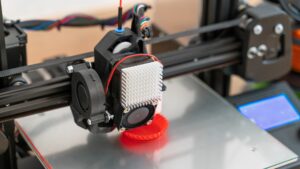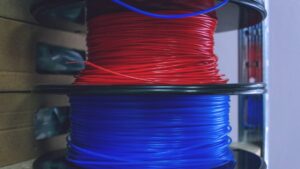
A Look at the Different Densities of 3D Printing Materials
There’s so much to learn about 3D printing materials. Come and find out what to look for when examining the different densities of 3D printing filaments.
844-810-1385
Food prep is essential, but in order to fully prepare, the restaurant industry needs food-safe utensils to make the food and eating utensils for diners. From PLA to nylon, you’ll learn the top five food-safe filament types for the restaurant industry to use for cooking utensils and cutlery.
PLA is a certified fiber that kitchen workers can use to enhance their eating utensils and food prep equipment. PLA is a safer material because there’s no trace of toxic chemicals. Avoid using dyes or additives containing phthalates, nitrates, and synthetic artificial food colors when using this filament type.
PLA is best for packaging foods; once injected with molding, the wrappers keep their shape, so you can store the food more safely and keep it packaged for an extended time. It also works well for biodegradable plastic cookie cutters.
PET and PETG are different fibers. You’d use PET for plastic bottles and storage containers for spices, powders, and other loose ingredients. In 1941, scientists John Whinfield and James Dickson used an esterification process to heat glycols in terephthalic acid so they could combine PET and PETG to create PET. Both PET and PETG are eco-friendly, but PETG is shock-absorbent and survives higher temperatures.
PETG filament is a good plastic in 3D printing because it creates different equipment for food preparation. Everything from microwavable dishes to cups and cans, the PETG printer filament helps keep beverages fresh and protects liquids from overheating so the bottle or can doesn’t explode.
Ceramic has been around for thousands of years, and the process stayed the same until 3D printing came along. Ceramic is a non-toxic material, which is great for restaurant use.
From cups to spoons and muffin pans, ceramic is an easy and affordable material for 3D printing. Additionally, ceramic dishes, cookware, and utensils last a long time, saving you money on materials to create more.
Nylon is an FDA-approved substance to use in a 3D printer. You might be worried about whether nylon would leach into food. Rest assured, that won’t happen if you keep nylon utensils on a spoon rest in between cooking. The spoon rest prevents nylon from melting and not only ruining your pans but contaminating food. Although nylon can survive up to 400 degrees, it’s never good to leave the utensils unattended as they can melt quickly.
PEI is a rigid material that handles elevated temperatures, so it’s great to use when making sauces, syrups, and other hot liquids. Because of its outstanding properties, including chemical resistance, it’s an excellent filament to use in food production.
Food safety is big in food manufacturing. To make practices better for the restaurant industry, food manufactures need to use one of five food-safe filament types. You can find more on food-safe filaments while browsing Filamatrix. Our filament stock works great for any business and does wonders for the restaurant industry.

There’s so much to learn about 3D printing materials. Come and find out what to look for when examining the different densities of 3D printing filaments.

Those interested in 3D printing have a lot to learn on how to use the system properly. Find out what you need to know about 3D printing and humidity levels.

3D printing has many variables that both beginners and experts need to know. Find out what effects temperature has on 3D printer filament.
Get professional insights, industry news, and our latest deals